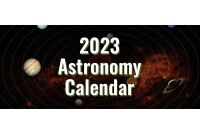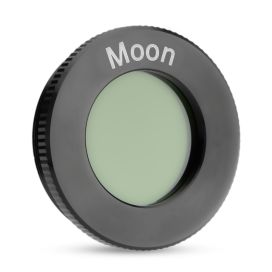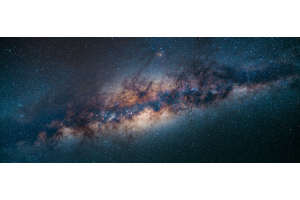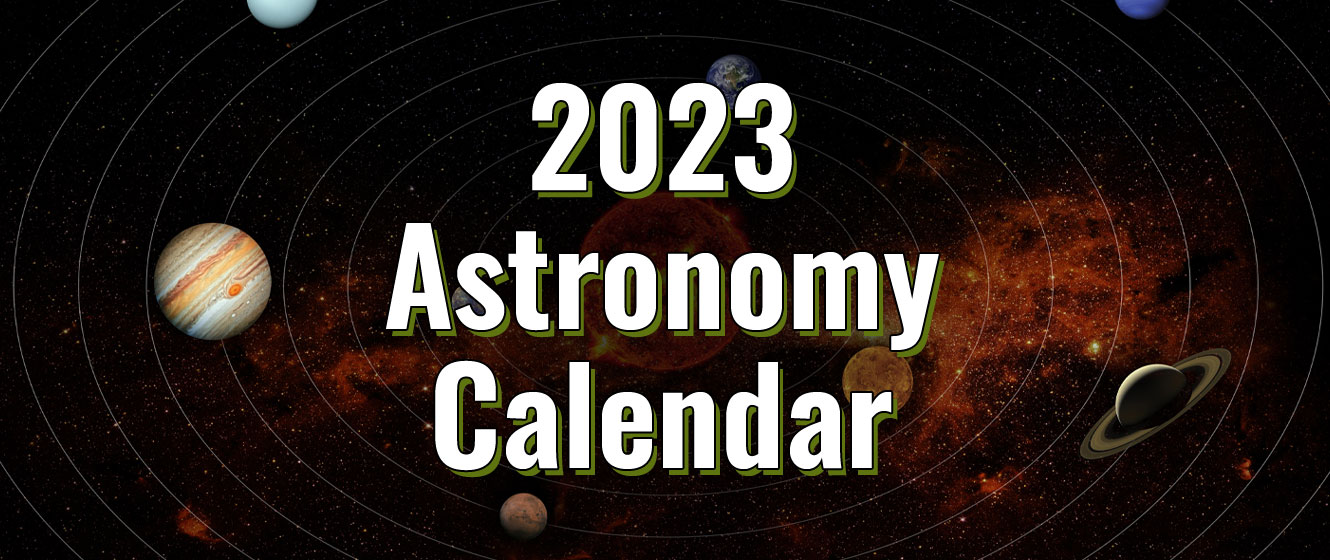
When it comes to astronomy, every year is a little different and every year brings its highlights. This year starts with the Quadrantid meteor shower and every planet, except Mercury, is visible in the evening sky. The closest naked-eye planetary conjunction of the year occurs on January 22nd, between Venus and Saturn, with Mercury reaching its best morning visibility on the 30th.
February brings several close encounters between the Moon and planets, while March sees conjunctions between Venus and Jupiter, Mercury and Jupiter, Mars and the open star cluster Messier 35, and also Venus and Uranus.
Venus then passes close to the Pleiades star cluster in April, with Mercury reaching elongation in the evening sky that same month. Venus continues its journey in May and passes close to Messier 35, with Mercury slipping into the morning sky.
Both Venus and Mars will pass by Messier 44, the Beehive Cluster, in June, before coming together at the end of the month. Venus is also at its evening best on the 4th. Venus and Mars then appear close to Regulus in July, with Mercury returning to the evening twilight at the end of the month as Venus quickly disappears from view.
August will be busy. It sees the Perseid meteor shower, plus two super full moons, the second of which is a Blue Moon with a potential occultation of Antares for some observers. Mercury is also at its best in the evening sky and Saturn reaches opposition on the 27th.
September sees Neptune at opposition and Mercury briefly dipping into the morning twilight, with the big event of the year - the North American annular solar eclipse - taking place in October. Jupiter and Uranus both reach opposition in November, and the Leonid meteors could have two maximums.
Lastly, December ends the year with Mercury shining in the evening twilight and the Geminid meteors promising a splendid show.
While these events have been compiled with North American observers in mind, the majority can also be seen throughout the rest of the world. Check an astronomical app, magazine, or other resource for more specific information relating to your location.
JANUARY
January 3/4 - The Quadrantid Meteor Shower
Unfortunately, 2023 is not the best year for the Quadrantids, as they occur when the Moon is a waxing gibbous. This will have the unfortunate effect of brightening the sky, thereby making many of the fainter shooting stars invisible. The predicted peak is around 10:40 pm ET on the 3rd, but your best bet may be to go outside a few hours before dawn on the 4th; by this time, the Moon will be low in the west, which will minimize its effect. Boötes, the constellation from which the meteors appear to originate, will be rising in the northeast. Keep your eyes peeled - Quadrantids are bright, and can often produce fireballs!
January 6 - Full Moon
Full Moon occurs at 6:09 pm ET, which means those on the east coast could potentially see the Moon rising in the east-northeast at the moment it turns full. It’ll be in Gemini, near Castor and Pollux, the two stars that mark the heads of the celestial twins. January’s full Moon is known as the Wolf Moon, as the wolves are known to howl around this time. However, they’re not howling at the Moon, but rather calling to other wolves or claiming their territory!
January 19 - Waning Crescent Moon and Mercury
Mercury reaches its greatest elongation - ie, its greatest distance from the Sun in the sky - on the 30th, and although this will probably be your best opportunity to catch the tiny planet in the predawn sky this year, the 19th is the only time when the Moon is relatively nearby. You’ll see the crescent Moon over the southeastern horizon about 30 minutes before sunrise. Look 14 degrees toward the east (ie, to the left of the Moon) and you may see a “star” at a slightly lower altitude and glinting pinkish-white against the brightening sky.
January 22 - Waxing Crescent Moon, Venus, and Saturn
Venus and Saturn will be drawing closer together at the start of the year, but will only be a third of a degree apart on the 22nd, making this the closest naked-eye planetary conjunction of the year. Venus, by far the brightest of the pair, will be easily visible toward the west-southwest shortly after sunset, while much fainter Saturn will appear beside it, slightly to its right. Look out for a slender crescent Moon hugging the horizon directly below the pair; it’ll be to the upper left of the planets by tomorrow evening.
January 25 - Waxing Crescent Moon and Jupiter
After passing Venus and Saturn, the crescent Moon will next pay a visit to Jupiter, the largest planet. You’ll find the planet just above the Moon in the evening twilight, with the pair fitting nicely into the same 10x50 binocular field of view.
January 30 - Waxing Gibbous Moon and Mars
Mars will be the next stop on the Moon’s tour of the planets. The good news is that you won’t have to get up early or stay out late to see this, as the pair will be visible throughout the evening. Mars still appears pretty bright after reaching opposition in early December and remains among the stars of Taurus. This gives you a good opportunity to compare its hue to nearby Aldebaran, the star that marks the red eye of the bull. The red planet will be just a little to the upper left of the waxing gibbous Moon tonight.
FEBRUARY
February 5 - Full Moon
For fairly obvious reasons, February’s full Moon is known as the Snow Moon, but if you’re looking for an alternative, you might prefer the Hunger Moon (as food was in short supply) or the more appealing Bear Moon (as this is when the cubs are born). Other names include the Eagle Moon, Raccoon Moon, Goose Moon, or Groundhog Moon. February’s full Moon occurs at 1:30 pm ET, but you’ll see it in the evening close to the backward question mark asterism that forms the head of Leo, the Lion.
February 18 - Waning Crescent Moon and Mercury
By mid-month, Mercury will be almost gone from the predawn sky, but you might have one more chance to spot it on the 18th - with a little help from the waning crescent Moon. You’ll need to be quick, as neither the planet nor the Moon will rise long before the Sun. If you have an unobstructed view of the southeastern horizon, take a look outside about 20-25 minutes before sunrise. The Moon will be very low, around five degrees above the horizon, with Mercury appearing at the same altitude some seven degrees to its left.
February 21 - Waxing Crescent Moon and Venus
When it comes to the planets, none are brighter than Venus, and you’ll have no problem spotting it in the evening sky. On February 21st, you’ll see it toward the west after sunset, with the one-day-old Moon directly below it and Jupiter a little further away and to its upper left. Keep your eye on the two planets as they’ll draw closer together over the next week.
February 22 - Waxing Crescent Moon and Jupiter
The crescent Moon and Jupiter will form a tight pair in the twilight of the 22nd, with the planet a little more than a degree to the upper right of the Moon. Observers in the eastern and central time zones will have the opportunity to see the two at their closest. At 7:38 pm ET (6:38 pm CT) the pair will be just a little more than 1.2 degrees apart, which should make for a nice view through both binoculars and telescopes.
February 27 - First Quarter Moon and Mars
Lastly, we come to Mars, and while observers in the eastern half of North America were favored with the Moon and Jupiter on the 22nd, observers in the western half will fare better this time around. The two will be at their closest - slightly less than 42 arcminutes apart - at 1:03 am ET on the 28th, or 10:03 pm PT on the 27th, with Mars appearing just to the left of the Moon.

MARCH
March 1 - Venus and Jupiter
If you keep your eyes on Venus and Jupiter throughout the last week of February, you’ll see the two draw closer together in the sky. Venus will be the brighter of the pair, and by the 1st, golden Jupiter will appear just a little to its left. Only half a degree will separate them, which is roughly the diameter of the full Moon, making it possible to see them both together within the same low-powered telescopic field of view. A magnification of around 30x should reveal Jupiter’s disc, but you’ll probably need to double that to get a similar result from Venus.
March 6 - Full Moon
The Moon turns full in the early hours of the 7th, which means it’s best seen on the evening of the 6th. At that time, it’ll be in Leo, the Lion, about halfway along the length of the constellation. The March full Moon is known as the Worm Moon, and it was originally believed this was due to the earthworms that would appear in the soil at this time. However, more recent research has indicated that some Native Americans gave the Moon this name when beetle larvae could be seen emerging from trees.
March 22 - Waxing Crescent Moon and Jupiter
Jupiter will be slipping into the evening twilight by late March, but should still be visible for a short while after sunset. Go outside 20 minutes after sunset and you’ll see the one-day-old Moon low over the western horizon. Just to its lower right, a little more than a degree away, shines Jupiter. At magnitude -2.1, it’ll be bright enough to be visible to the naked eye, with both worlds providing a nice view through binoculars or a telescope at low power.
March 27 - Mercury and Jupiter
There’s an opportunity to catch Mercury and Jupiter together in the evening twilight - but you’ll need to be quick, as both planets will set shortly after the Sun. If you have a clear, unobstructed view of the western horizon, look toward the west about 20 minutes after sunset for Jupiter. It’ll still be shining relatively brightly, but it’ll be low, so you may need binoculars to help you find it. Within the same field of view, about a degree and a quarter away to Jupiter’s right, will be Mercury. It’ll be slightly fainter, but once you find it with binoculars try locating it again with just your eyes.
March 29/30 - Mars and Messier 35
Mars will cross into Gemini from Taurus on the 26th but will appear within the same binocular field of view as the open star cluster Messier 35 from about the 19th onward. It’ll be closest to the cluster on the 29th and 30th, just 1.2 degrees away, giving visual observers and astrophotographers a rare opportunity to catch the two together. Unfortunately, the Moon will be a waxing gibbous and close to Castor and Pollux on the 29th, and then passing through neighboring Cancer on the 30th. As a result, the sky will be brighter, making the cluster a little harder to spot than usual.
March 30 - Venus and Uranus
This close encounter involves Uranus, and it’s the only one you’ll be able to see involving that planet this year. Venus starts the month with Jupiter, but brings March to a close with its more distant sibling. The two will appear within the same binocular field of view from the 25th but will be closest on the 30th when 1.2 degrees will separate them. However, Uranus lies on the very edge of naked eye visibility, so you’ll need dark skies to see it. You can start your search about an hour after sunset when astronomical twilight begins and Venus will still be about 20 degrees above the western horizon. With binoculars, look for a tiny, pale blue star just to the left of the planet. If you have no luck, try again in another 20 minutes or so. True darkness occurs about 90 minutes after sunset, but don’t wait too long as the lower the planets fall, the more susceptible they’ll be to atmospheric distortion.
APRIL
April 5 - Full Moon
April’s full Moon is commonly known as the Pink Moon, as April is the time of year when the phlox flowers bloom. The Moon turns full shortly after midnight, eastern time, on the 6th, which means it’ll be best seen throughout the evening of the night before. You’ll find it among the stars of Virgo, with Spica, that constellation’s brightest star, a little less than nine degrees below it.
April 10/11 - Venus and Messier 45
Every few years Venus makes a close pass by the Pleiades star cluster, sometimes even moving among the stars themselves. Unfortunately, that’s not the case in 2023, but it will pass 2.6 degrees to the cluster’s south on the 10th and 11th. You’ll need to make sure the skies are dark enough to see the stars of the cluster itself, so it might be a good idea to wait until about an hour after sunset. You’ll see Venus in the west, and you may also see a few of the Pleiades glinting, but otherwise, binoculars will provide a fine view.
April 11 - Mercury at Greatest Eastern Elongation
Mercury will reach its first eastern elongation of the year this month, making it visible in the evening sky after sunset. The good news is that it’ll appear at a respectable altitude (about 12 degrees) in the west-northwest, roughly thirty minutes after sunset. The bad news is that at magnitude 0.1, it’s not the brightest, but there are no other bright stars or planets nearby and the Moon will be nowhere in sight, giving you a chance to spy the elusive planet. Try drawing a line through Venus toward where the sun went down and then looking about a third of the way between the horizon and that planet. Binoculars, as always, will help the search.
April 20 - Hybrid Solar Eclipse
If you need a vacation but don’t have the incentive to go, April’s hybrid solar eclipse might be just the reason you need. A hybrid solar eclipse is a rare event where both a regular total solar eclipse and an annular eclipse are both visible, depending upon your location along the path of totality. In this case, observers in the Indian Ocean at the start of the path of totality, or in the Pacific Ocean, at the end of the path of totality, will see an annular eclipse, while everyone else (eg, East Timor or West Papua) will see a regular, total solar eclipse.
April 22/23 - The Lyrid Meteor Shower
2023 could be a good year for the Lyrids. Coming shortly after the new Moon, there’ll be little interference from moonlight, thereby giving you a good chance of being able to see a few shooting stars. The shower is predicted to reach its maximum at around 01:00 UT (9:00 pm ET on the 22nd) but it’s probably best to wait until about three hours after sunset when the skies are truly dark and Lyra - the constellation from which the meteors appear to originate from - will be rising over the northeastern horizon. Under ideal conditions, you could expect to see about 18 meteors an hour, so be sure to find a dark location to enjoy the view!

MAY
May 5 - Full Moon and Penumbral Lunar Eclipse
Eclipses always come in pairs, and following the hybrid eclipse of April 20th, we have a penumbral lunar eclipse. If you’re in Europe, Africa, Asia, or Australia, you’ll be able to witness this for yourself, but since mid-eclipse occurs at 17:22 UT, it will still be daylight for observers in North America. This might not matter too much, as penumbral eclipses only slightly dim the Moon’s light and many casual observers might not notice a difference at all. As a consolation, those in the Americas can enjoy the solar eclipse in October.
May 8/9 - Venus and Messier 35
There are a small number of star clusters that lie along the ecliptic - the path the Sun, Moon, and planets follow as they move among the stars. One of those is Messier 35, near the feet of Gemini the Twins. Venus will appear within the same binocular field of view as the cluster from the 4th to the 13th, with the gap between them being a little less than two degrees on the 8th and 9th. As with the Pleiades and Messier 44, it’s best to wait until a few hours after sunset, when the skies are dark and the fainter stars of Messier 35 are better visible.
May 17 - Waning Crescent Moon and Jupiter
Jupiter will be in conjunction with the Sun on April 11th and should start emerging into the predawn twilight by early May. The waning crescent Moon will appear just a degree to its right on the morning of the 17th, with the best views coming at about 45 to 30 minutes before sunrise. You’ll find them both low over the eastern horizon, with binoculars providing a fine view for any early-rising observers.
May 23 - Waxing Crescent Moon, Venus, and Mars
After turning new on the 19th, the Moon will then return to the evening sky and start another tour of the planets. First along the way is Venus, with the crescent Moon appearing six degrees to its lower right on the 22nd. The following night you’ll find the Moon between that planet and its much fainter neighbor, Mars. The red planet will appear nine degrees to the upper left of the Moon, with the stars Castor and Pollux just to the upper right. If Mars proves elusive, try again on the 24th, when the Moon will hang about four degrees almost directly above it. Messier 44, the Beehive Cluster, will also be within the same binocular field of view, but the bright light of the Moon might make it difficult to see.
May 29 - Mercury at Greatest Western Elongation
This will be Mercury’s second morning elongation of 2023, but despite being an impressive 25 degrees west of the Sun, it will remain a difficult target. At the end of January, its previous morning apparition, the planet was a reasonably bright magnitude -0.1, but this time around it’ll be a much fainter 0.6. However, brilliant Jupiter will shine ten degrees to its upper right and can help you locate the smaller planet. Try your luck by looking east about 30 minutes before sunrise, and if Mercury isn’t readily apparent, scan the area to the lower left of Jupiter with binoculars.
JUNE
June 2 - Mars and Messier 44
With both Venus and Mars visible in the evening sky during the first half of the year, we’ll have the opportunity to see those planets skim past several bright star clusters. This time, Mars will appear against the backdrop of Messier 44, the Beehive Cluster. The two will be within the same binocular field of view from the 23rd, and the planet will reach the edge of the cluster on June 1st, but the 2nd is when Mars will appear embedded within it. Unfortunately, the conditions won’t be ideal as the pair will be fairly low in the west and there’ll be a nearly full Moon rising in the southeast. Astronomical twilight doesn’t end until two hours after sunset, but the cluster may be bright enough to make it worth observing an hour after the sun goes down.
June 3 - Full Moon
June’s Full Moon occurs at 11:41 pm ET on the 3rd, making it possible for observers across North America to see it with its disc entirely illuminated. You’ll find it just three degrees to the left of the bright, coppery star Antares in Scorpius, the Scorpion. This month’s full Moon is known as the Strawberry Moon, as this is the time when the fruit is harvested. Other names include the Blooming Moon and even the Hot Moon.
June 4 - Venus at Greatest Eastern Elongation
Venus dominates the evening sky for the first half of the year and will be at its best at the start of June. It crosses into Cancer from Gemini on the 3rd and then slowly catches up to Mars. The two will be closest at the end of the month, but Venus won’t be able to pass the slower planet before it starts to slip back toward the Sun. Venus will be 45 degrees from the Sun at greatest elongation and won’t set until a little more than three hours after sunset, giving you plenty of time to enjoy our nearest planetary neighbor.
June 13 - Venus and Messier 44
The last planet and star cluster conjunction takes place between Venus and the Beehive Cluster. Unlike Mars, Venus won’t move directly through the cluster but will pass just a little to the north instead. Again, you’ll most likely need to wait at least an hour after sunset for the stars of the cluster to become visible, but that could vary depending on your local sky conditions. With roughly 0.8 degrees between them, the planet will appear to the upper right of the cluster through binoculars.
June 16 - Waning Crescent Moon and Mercury
Here’s a sight that could prove to be challenging. Mercury was at its morning best more than two weeks ago but may still be glimpsed very low over the north-northeastern horizon. A thin, waning crescent Moon, just 3% illuminated, will hang directly above it on the morning of the 16th. Step outside about 20 minutes before sunrise; if you can see the Moon, look about midway between the Moon and the horizon for faint Mercury. This could be one of your last chances to spot the planet before it disappears into the Sun’s glare.
June 21 - Waxing Crescent Moon, Venus, and Mars
New Moon occurs shortly after midnight, eastern time, on the 18th, with a waxing crescent appearing close to Venus and Mars on the 21st. This gives North American observers a rare opportunity to see the three worlds together in the evening sky. While the three are close, east coast observers may find they’re just a little too far apart to fit within the same 10x50 binocular field of view, although lower magnification binoculars might still do the trick. West coast observers will have better luck, as the Moon will have moved in the intervening hours.
June 28 - Venus and Mars
It’ll take a long time to get there, but Venus will finally catch up to Mars in the evening sky on the 28th. The two will appear within the same binocular field of view from mid-month onwards, and will now be 3.6 degrees apart, with the distance closing very slightly over the next 24 hours. At magnitude -4.5, Venus is, by far, the brighter of the pair, with Mars a much fainter magnitude 1.7. Look out for Regulus, the brightest star in Leo, the Lion, to the upper left of the pair. At magnitude 1.4, its brightness is comparable to Mars but its white color more closely resembles Venus.

JULY
July 3 - Full Moon
This month’s full Moon occurs in the eastern half of Sagittarius, not far from the border with Capricornus, with no bright stars nearby. The nearest star brighter than magnitude 1 is Altair, some 36 degrees to its north. July’s Moon is commonly known as the Buck Moon, as this is the time of year when the antlers of the male deer grow. Other names include the Halfway Summer Moon, the Salmon Moon, the Raspberry Moon, and the Thunder Moon.
July 9 - 12 - Venus, Mars, and Regulus
There’s a great opportunity to see Venus, Mars, and Regulus together in the evening sky from the 9th to the 12th. The three will appear within the same binocular field of view from the 6th to the 13th, with Mars catching up to and then passing Regulus during that time. The red planet and the star are closest on the 9th, with three-quarters of a degree separating them. The two will be of nearly equal brightness, but Mars will show a distinct, coppery color. Return on the 10th to see how Mars has moved, and then on the 11th and 12th to see the star aligned with both planets.
July 18 - Waxing Crescent Moon and Mercury
Summer gives us the best opportunity to see Mercury in the evening sky this year, with the smallest planet being visible in the twilight from mid-July to the end of August. If you’ve never seen Mercury before, then this is the perfect time to spot it, especially since Venus and Mars will also be visible at the same time. This places all the terrestrial planets together in the same area of the sky, and on the 18th, the crescent Moon will join them. Look toward the west-northwest about 15 minutes after sunset. The Moon will appear low over the horizon with Mercury about 5.5 degrees to its left. Venus will be shining brilliantly, with the star Regulus directly above it and Mars about twice the distance and to its upper left.
July 27/28 - Mercury and Regulus
By the end of July, Venus will be rapidly losing ground to the Sun while Mercury continues to climb. The two planets won’t pass close to one another this time around, but Mercury will form a very close conjunction with Regulus on the 28th. Looking west at 20 minutes after sunset, Venus will be very low over the horizon while Mercury should be easily visible about 5.7 degrees directly above it. Regulus lies just 0.1 degrees to the right of Mercury, but its proximity to Mercury and the brightness of the background sky might make it a little tricky to spot. As always, using binoculars will certainly help.
AUGUST
August 1 - Full Moon (Supermoon)
August is something of a special month, as it will provide us with two Super Moons, with the second also being a Blue Moon. A Super Moon is defined as a full Moon that occurs when the Moon is within 10% of its closest distance from the Earth, and of the two Super Moons this month, the first is the more distant. It occurs in the constellation Capricornus, with the closest object brighter than magnitude 1 being Saturn, roughly 21 degrees to its east. August’s full Moon is commonly known as the Sturgeon or Corn Moon.
August 9 - 13 - Mercury and Mars, with Mercury at Greatest Eastern Elongation
Venus will be gone from the evening sky by the beginning of August, leaving Mercury and Mars alone in the twilight. Looking toward the west about 20 minutes after sunset, the pair will be fairly low over the horizon. While Mercury is the brighter of the two, it will be lower in the sky and its light will be dimmed as a result. Mercury reaches greatest elongation on the 9th, and with 13 degrees separating the planet from the Sun, this is your best chance to spot it in the evening throughout 2023. Watch as the two planets draw closer over the next few nights. The gap decreases to 4.7 degrees on the 12th and 13th before then widening again.
August 12/13 - The Perseid Meteor Shower
Of all the meteor showers, the Perseids are by far the most famous. Every year, at around this date, they can produce around 100 meteors an hour, earning the shower a reputation for reliability that few others can match. This year, the Moon is a waning crescent and won’t brighten the sky, thereby allowing you to see all but the faintest shooting stars. According to the International Meteor Organization, the shower is expected to peak between the hours of 3:00 am and 10:00 am ET on the 13th. With this in mind, east coast observers will have the best chance between 3:00 am and 4:00 am (before the dawn brightens the sky) whereas observers on the west coast should look between midnight and 3:00 am PT.
August 18 - Waxing Crescent Moon, Mercury, and Mars
Mars will be harder to spot in the twilight by mid-August, as it’ll be growing dimmer and sinking lower into the west. The waxing crescent Moon appears beside it on the 18th, with Mercury directly below the pair. You’ll need to be outside around 20 minutes after sunset if you want to see all three; Mercury will vanish shortly after, with the Moon and Mars setting about 75 minutes after the Sun.
August 24 - Lunar Occultation of Antares
The Moon passes by Antares every month, but this month we’re treated to a rare event - an occultation. Occultations occur when the Moon passes in front of another celestial object and temporarily hides it - and like a solar eclipse, the timing and visibility of the event will vary, depending on your location. Antares will disappear close to 11:00 pm ET for east coast observers, but the Moon will be below the horizon by the time the star emerges. If you’re in the north-midwest you stand a good chance of being able to see the star re-appear, while those in the southern states between Alabama and Texas should witness the entire occultation from start to finish. Be sure to check with your favorite app or The International Occultation Timing Association for more information.
August 27 - Saturn at Opposition
Opposition occurs when an outer planet (ie, Mars, Jupiter, Saturn, Uranus, or Neptune) is directly opposite the Sun in the sky. When this happens, it’s at its closest to the Earth for the year, appears brightest in the sky, appears largest through a telescope, and is visible throughout the entire night, from sunset to sunrise. As such, it’s the best time to observe the planet in question. Mars was at opposition in December last year and won’t be there again until January 2025. Of the rest, Saturn will be the first to reach opposition in 2023; at that time it’ll be in Aquarius, and even though it’s the faintest of the naked eye planets, at magnitude 0.4 it far outshines any of that constellation’s stars. Look for a solitary, bright pale yellow “star” rising in the southeast a few hours after sunset.
August 30 - A Super Blue Moon
As mentioned, August has two full Moons, and as is customary in popular culture, the second is known as a Blue Moon. However, this Blue Moon is also a Super Moon, when the Moon is at its closest to the Earth. As a result, the Moon appears larger than usual, but will you notice a difference? The Moon turns full at 09:36 pm ET, giving observers on the east coast the opportunity to judge for themselves. Its apparent diameter will be 33.6 arcminutes, or almost 6% larger than the average 31.7 arcminutes. Regardless, look out for bright Saturn just to the west.

SEPTEMBER
September 19 - Neptune at Opposition
Neptune is the second of the outer planets to reach opposition, but unlike Saturn before it, you’ll need binoculars or a telescope to spot it. Neptune moved into Pisces from Aquarius on March 4th and will be very close to the border of both constellations. It can be found below the Circlet asterism; just under four degrees separate Iota and Lambda Piscium, the two easternmost stars of the Circlet, and by drawing a line between the two and then continuing for another five degrees, you’ll come to Neptune. Look for a distinctly blue “star” that shines with a steady light.
September 22 - Mercury at Greatest Western Elongation
This will be Mercury’s third and final morning elongation of 2023, and although there’s no Moon nearby to act as a marker, at magnitude -0.4, it should be bright enough and high enough to be easily visible. Step outside about 30 minutes before sunrise and you’ll see Venus shining brilliantly in the east. To its lower left, and at about a third of the altitude of Venus, is Mercury. Look carefully and you should also see Regulus glimmering about halfway between them.
September 26 - Waxing Gibbous Moon and Saturn
Three days prior to the Moon turning full, it passes to the south of Saturn in the sky. The light of the Moon will drown out the surrounding stars, but Saturn itself will be bright enough to remain visible. Slightly more than three degrees will separate the pair, making them a viable target for binocular observers.
September 29 - Full Moon
As many people know, September’s full Moon is usually known as the Harvest Moon, but not everyone is aware that this isn’t always the case. The Harvest Moon is whichever full Moon occurs closest to the autumnal equinox, and if September’s full Moon occurs at the beginning of the month, then October’s full Moon becomes the Harvest Moon instead. However, in most years - including this year - this isn’t the case, and you’ll find the Harvest Moon shining among the faint stars of Pisces on the 29th.
OCTOBER
October 1 - Waning Gibbous Moon and Jupiter
Jupiter will be slightly more than a month away from opposition by early October but will be well-placed for observation from mid to late evening onward. It’s joined by the Moon on the 1st, a little more than a third of the way between the stars of Aries and Taurus. About 3.2 degrees will separate the Moon and the planet, with Jupiter shining to the west of the Moon.
October 10 - Waning Crescent Moon, Venus, and Regulus
Rise early to see the waning crescent Moon, Regulus, and Venus aligned in the predawn twilight of the 10th. The crescent Moon, complete with Earthshine, will be approximately 3.7 degrees to the left of the star Regulus, while Venus will be 2.4 degrees to its lower right. If you have 10x50 binoculars, you may be able to fit all three within the same field of view, but otherwise, you’ll need to opt for something with a little less magnification.
October 14 - Annular Solar Eclipse
North Americans are treated to two solar eclipses within the space of six months, and October brings us the first, an annular solar eclipse. An annular solar eclipse occurs when the Moon is a little further away than usual and, as a result, appears a little smaller in the sky. This means it’s unable to entirely eclipse the Sun, and observers see a ring of light instead. This particular eclipse begins off the northwestern coast of the United States before making landfall in Oregon. It will then move through Nevada, Utah, Arizona, New Mexico, and Texas before then crossing the gulf into Central and South America. To learn what you can expect from your location, visit timeanddate.com or greatamericaneclipse.com.
October 21/22 - The Orionid Meteor Shower
The Orionids, while not on par with the Perseids or Geminids, can produce between 20 and 30 meteors under ideal conditions. As with most showers, they’re best seen in the early hours of the morning, and with the Moon reaching first quarter on the 21st, it should be setting at around midnight. Fortunately, this is roughly when Orion itself will be rising over the east-southeastern horizon, thereby making it easier to spot any shooting stars in the hours before dawn.
October 23 - Venus at Greatest Western Elongation
Venus reaches greatest elongation in the evening sky on June 4th, and then, less than five months later, it reaches greatest elongation in the morning sky. At this time it’ll be moving through Leo, but more or less alone in the predawn twilight. Leo’s brightest star, Regulus, will be the only relatively bright nearby object, some 13 degrees above it.
October 28 - Full Moon and Jupiter
October’s full Moon brings with it a partial lunar eclipse, and while most of the populated world will have the chance to witness it, most of those in the Americas will be out of luck. Anyone in the northeastern corner of the US or Canada may see part of the penumbral phase at moonrise, but this will be as the eclipse is ending. This full Moon is known as the Hunter’s Moon, and it’ll appear below the stars of Aries, with Jupiter only 3.5 degrees to the southeast.

NOVEMBER
November 3 - Jupiter at Opposition
This year, Jupiter reaches opposition in the constellation of Aries, the Ram, and will therefore rise to a significant altitude for observers in the northern hemisphere. At magnitude -2.9, it’ll be the brightest object in the evening sky and easily identifiable by its unmistakable, brilliant golden light. As always, binoculars will show its four largest moons, while a telescope will show the dark bands of its atmosphere and - if your equipment and observing conditions allow - the Great Red Spot.
November 9 - Waning Crescent Moon and Venus
By November 9th, Venus will be moving through the faint stars of western Virgo, roughly midway between Spica, that constellation’s brightest star, and Regulus, the brightest star of neighboring Leo. While it typically appears quite solitary, on this particular morning it’s joined by the waning crescent Moon. With four days until the Moon turns new, there’ll also be a good opportunity to see Earthshine illuminating the darkened portion of its surface. Roughly a degree and a half separate the Moon and the planet, making this a wonderful sight for both astrophotographers and visual observers alike.
November 13 - Uranus at Opposition
Uranus will be the last planet to reach opposition this year, and while it shares the southern stars of Aries with Jupiter, it certainly doesn’t share the larger planet’s brightness. At magnitude 5.6, it lies at the very edge of naked-eye visibility, but you’ll need excellent seeing conditions and know exactly where to look to find it. Binoculars can make the search a little easier; start at 41 Arietis and then look about six and a quarter degrees southeast for Epsilon. If you’re using 10x50 binoculars, the star will probably appear on the edge, or just beyond, the field of view, with no brighter stars nearby. Uranus then appears five degrees to the southeast of Epsilon, with Delta (at almost the same brightness as Epsilon) forming a flattened triangle between them. Uranus itself will appear as a pale-blue point of light.
November 17/18 - The Leonid Meteor Shower
This year’s Leonids could prove interesting; for starters, with the Moon still a few days away from first quarter, it shouldn’t interfere with any meteors that might appear. Secondly, maximum is predicted to occur at either 5:00 pm ET (according to one model) on the 17th or 12:00 am ET on the 18th (according to the regular model), but while that favors observers on the east coast, Leo itself won’t rise until around 1:00 am ET, regardless. That being the case, it might be wise to observe from around 11:00 pm ET (8:00 pm PT), close to when the regular model predicts the maximum. If you miss it, you might have another chance on the 21st. According to the International Meteor Organization, there could be another peak at 7:00 am ET (4:00 am PT) on that date, with a potential for 10-15 brighter-than-average meteors being visible per hour.
November 26/27 - Full Moon
November’s full Moon is commonly known as the Beaver Moon, as this is the time when beavers build their dams and, perhaps due to their increased activity, the Native Americans would set their traps. Another common name is the Frost Moon. The Moon turns full in the early hours of the 27th, making the evening of the 26th the best opportunity to see it before midnight. At that time it’ll be 100% illuminated and close to the Pleiades, making the cluster all but invisible. The Moon will be 99% illuminated on the evening of the 27th and close to Elnath, the star that Taurus shares with neighboring Auriga.
November 29 - Venus and Spica
If you’re an early riser, you may have noticed Venus and Spica drawing closer together during the last week of the month. They’ll be within the same binocular field of view from the 26th, and at their closest on the morning of the 29th, when 4.2 degrees separate them. That said, if you miss it, come back on the 30th when the pair will be 4.3 degrees apart. They’ll then separate, but remain within the same 10x50 binocular field of view until the 3rd.
DECEMBER
December 4 - Mercury at Greatest Eastern Elongation
This is your last chance to see Mercury this year, but while it’ll be reasonably bright, there’ll be no Moon, stars, or planets nearby. You can start looking around 20 minutes after sunset; it’ll be low over the southwestern horizon, with perhaps your best chance coming at around 30 minutes after sunset. By that time the sky will have darkened but Mercury will still have sufficient altitude, making it easier to see.
December 9 - Waning Crescent Moon and Venus
The Moon appears beside Venus again on the 9th, and as with a month ago, it’ll be a waning crescent with Earthshine illuminating its darkened surface. You’ll find Venus itself hanging just to the left of the Moon, with Spica, the brightest star in Virgo, some way to the upper right of the pair.
December 14 - The Geminid Meteor Shower
While the Perseids might be the most well-known meteor shower, there’s a strong argument to be made for the Geminids being the best. In recent years, their zenith hourly rate - the number of shooting stars you could theoretically see per hour under ideal conditions - has risen to around 150, and with Gemini itself rising early in the evening, the constellation will be nearly overhead by around 1:00 am ET. This makes it a major shower that you can truly enjoy throughout the entire night, and with maximum predicted for 2:00 pm ET on the 14th, your best bet will be to step outside in the hours before dawn or after sunset on that date. Lastly, as a bonus, the Moon will be just a few days old and won’t brighten the sky sufficiently to drown out any shooting stars. Short of the maximum occurring when Gemini is highest, it doesn’t get much better than this.
December 22/23 - The Ursid Meteor Shower
The Ursid meteor shower is the last major shower of the year, and while they typically only have a zenith hourly rate of around ten shooting stars, the shower might be worth a look for several reasons. Firstly, the maximum is predicted for 11:00 pm ET on the 22nd, giving observers throughout North America a chance to see the shower at its best. Secondly, the radiant is located close to Kochab in Ursa Minor, a star that can always be seen above the northern horizon. The bad news is that the Moon will be a waxing gibbous, and will significantly brighten the sky until it sinks toward the west-southwestern horizon at around 3:00 am ET.
December 26 - Full Moon
The Moon turns full in the mid-evening of the 26th. It’ll be among the eastern stars of Gemini at that time, on the border with the constellation Auriga. The stars Castor and Pollux, marking the heads of Gemini, the Twins, will be to its east, while yellowish Capella, the brightest star in the constellation Auriga, will be to the northwest of the Moon. For obvious reasons, December’s full Moon is known as the Cold Moon, but you might also hear it being called the Long Night Moon.
Free Printable Astronomical 2023 Calendar PDF
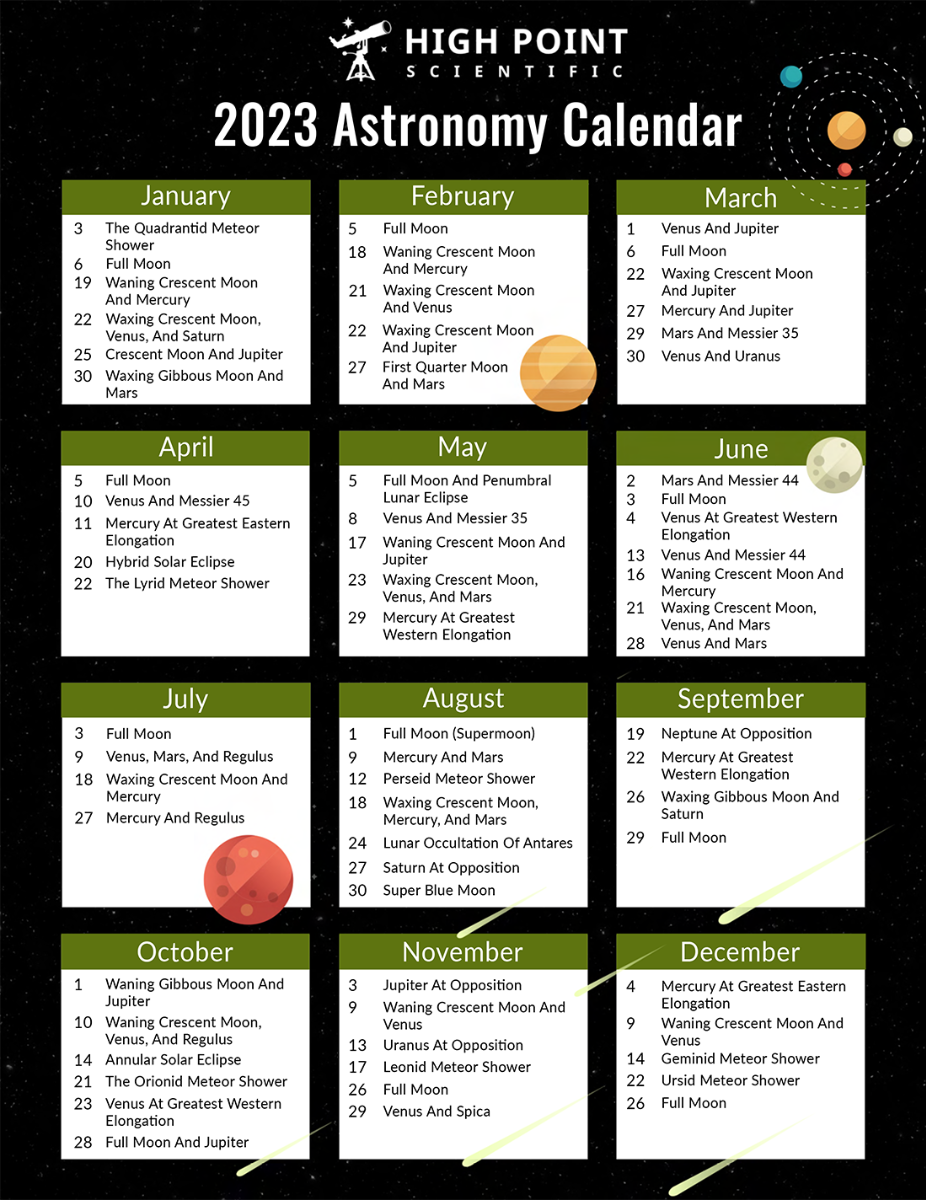
Note: This is a large file and may take a moment to load. If you are unable to print the PDF from your browser, we suggest opening it in a PDF program.
This Article was Last Updated on 05/02/2023

